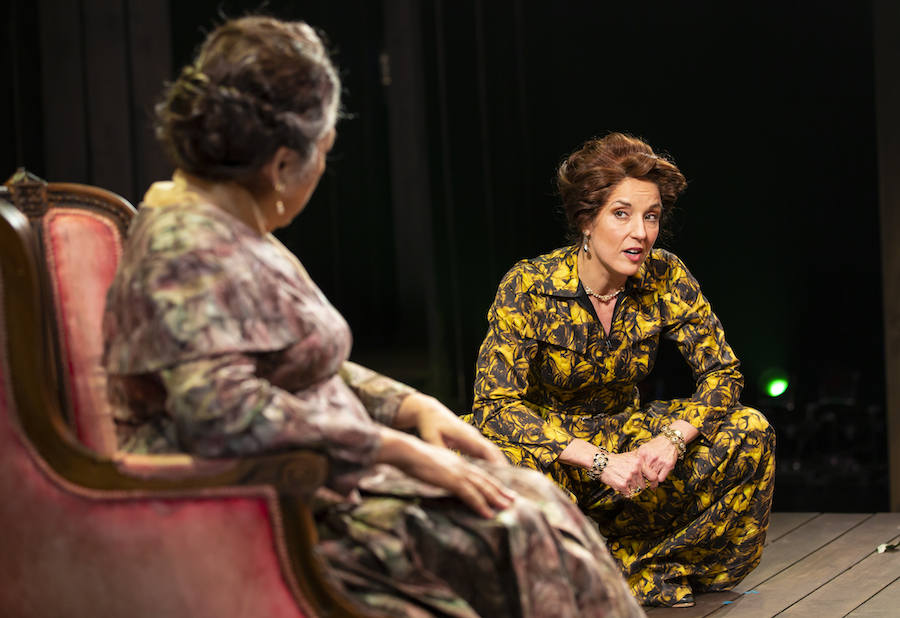
Long Wharf Theatre | Arts & Culture | Theater

| Maggie Bofill as Nora and and Mia Katigbak as Anne Marie in A Doll's House, Part 2. Performances run through May 26. T. Charles Erickson Photo. |
There's this moment a few minutes into A Doll's House Part 2 where the focus goes fuzzy. Onstage, a debate is raging at full force —Is marriage a good thing? Does it just keep women captive? Are the answers all in one book?—but suddenly it's hard to pay attention. You wonder if maybe you've read this book too, in a class on what second-wave feminism got right, and what it bungled.
As it closes its season on Lucas Hnath's A Doll's House, Part 2, Long Wharf Theatre succinctly answers what happens when a dynamic cast, ambitious crew, and sublime, adventurous set are paired with a draining script that is overly indebted to its source material. That is, the script sort of sputters and treads water, and the cast and crew jump in and save it.
The play runs through May 26. Tickets and more information are available here.
To understand A Doll’s House Part 2 is in part to understand where it comes from. In the last quarter of the nineteenth century, Norweigen writer Henrik Ibsen published A Doll’s House, following spouses Nora and Torvald Helmer through a marriage that first appears steady, and then is thrown into tumult. At the core of their distress is his ego and her economic limitations as a woman, which have both turned her Torvald’s doll—or so he thinks—and have pushed her to commit forgery in hopes of mending her husband’s health. When she is threatened with blackmail, he loses it, and she ultimately leaves.
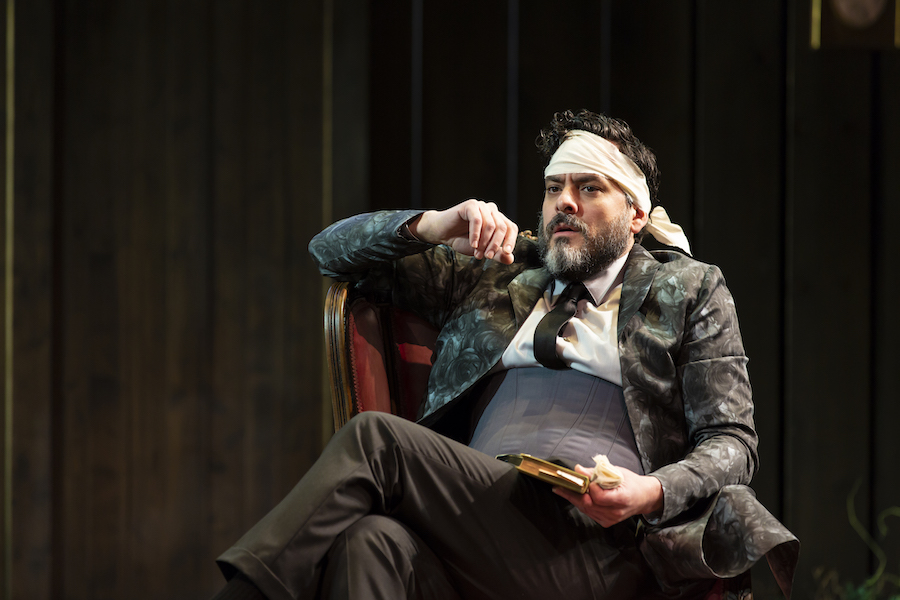
| Jorge Cordovaas Torvald. T. Charles Erickson Photo. |
If there’s a reason to watch a man tantrum on stage, this is it. Ibsen’s original is exhilarating, with a suspenseful build and kinetic dialogue that hits at exactly the right moments. He’s a good feminist long before it’s cool to be one. He comes out swinging hard against the patriarchy, painting Torvald as impish and totally oblivious to the systems that have rendered his wife powerless, and in which he is complicit. When Nora leaves, it’s hard not to do a little fist bump with whoever is sitting nearby.
Of course, the audience is left to wonder what happens after the curtain falls. But is that such a bad thing?
In Hnath’s sequel, Nora (a magnetic Maggie Bofill) walks back in. Sort of. Fifteen years have passed, and she’s now a famous feminist writer, publishing under a pseudonym that makes her hard but not impossible to find. One of her books has inspired enough women to leave their husbands that a judge is ready to blackmail her—with the news that her divorce was never finalized. If it's not, she risks jail time and a ruined career. So she’s back to get proper divorce papers from Torvald (Jorge Cordova), because she can’t file them as a woman and he has failed to do so in his anger and bitterness. Oops.
If she can’t convince him, can the other women in the house? What if they aren’t her immediate allies? There’s the nanny who raised her children and her petulant not-quite-ex (Mia Katigbak as an even-keeled and dryly funny Anne Marie) and her lone daughter Emmy (an effervescent Sasha Diamond), who has retaliated by choosing an entirely different life.
Hnath’s dialogue is at its best when snappy and charged, words flying between Nora and whoever is inevitably mad at her. In this telling, no one is entirely good and no one is entirely villainous, although women maintain the verbal upper hand while Torvald melts into progressive—and at times, quite funny—iterations of pathetic man child. It’s an irony that Hnath mines for humor: only the fallen patriarch, beneficiary of every privilege imaginable, is incapable of seeing what a big baby he is.
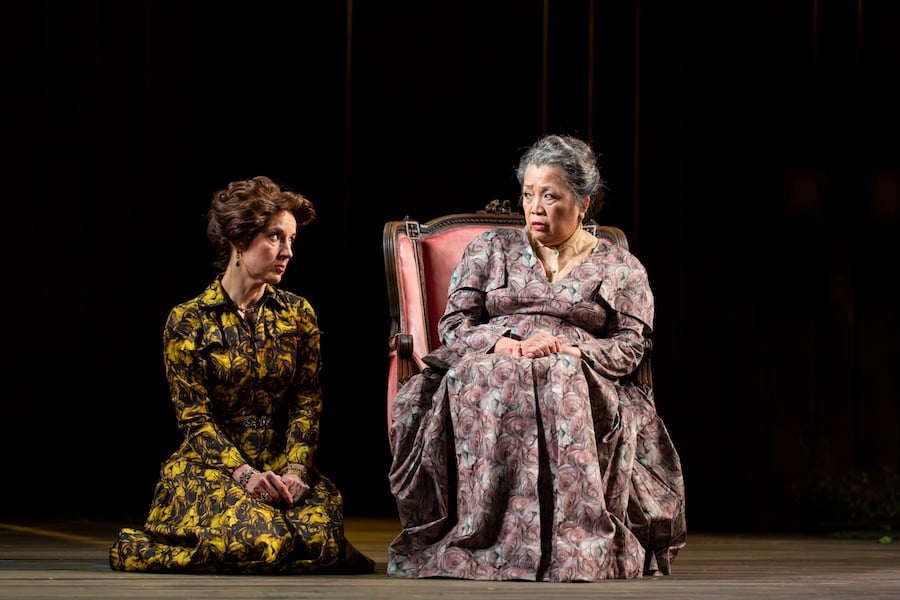
|
The team knows what to do with this script—more than Hnath himself did, it sometimes seems. Director Will Davis lifts up the playwright’s comedy and clipped, fast pacing, seeing how far actors can take it. The result is a world where everyone thinks they are in the right, and everyone is a little on edge. In the theater, a wild and imaginative Arnulfo Maldonado has covered the stage in a rainforested canopy, with bright green vines and tropical swags. It’s a magical, messy kind of take on the setting, other productions of which have put interactions in an enclosed, questionably Nordic and Victorian-looking room.
Instead, sticky heat practically rolls off the stage. Swarming bees and screeching monkeys fill the air (a nod to sound designer Jane Shaw), discordant with the mechanized coo of a wind up clock, the quiet shuffling of Anne Marie’s old feet. As they enter and exit the set, it’s as if the characters' inner tumult has grafted itself onto the landscape.
In this liminal space, costume designer Oana Botez has suspended characters between eras, not Victorian but not of the audience’s world either. Nora wears a sumptuous, wide-legged yellow printed jumpsuit, belted at the waist and flared at the hips, her legs swimming in fabric. In stark contrast is her daughter’s dress and giant bustle, which seems to spring ever higher as the two search for a solution. Anne Marie matches her style, with a dress that has the same print in a different color and wider, more modest cut. Even Torvald is so sartorially himself, as he nurses a back brace and pulls an ornate house coat around his shoulders in bat-like fashion.
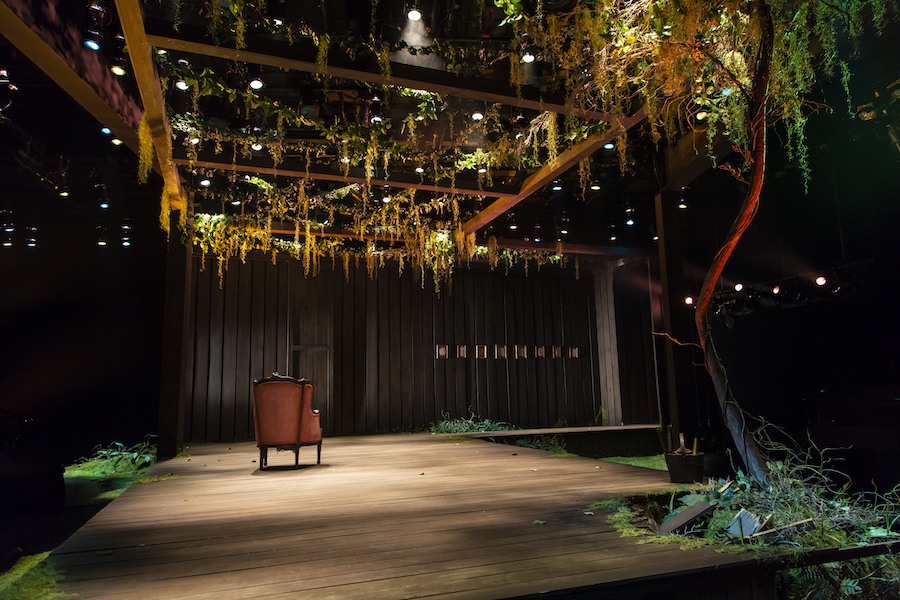
| Arnulfo Maldonado's set remains a high point of the show. T. Charles Erickson Photo. |
As Nora, Bofill is captivating from the moment she steps back through the door. No longer welcome in her own home, she sticks out like a sore thumb where she was once part of the décor: her voice is a butter and cream when talking to Anne Marie, but mashed scrap metal with Torvald, and somewhere in between as her daughter sweeps in. Watching them problem solve together is one of the high points in this show: Diamond digs in her lace-up boots to defend her choices, and she gets through to Nora. She is bubbly and fast but also cunning, with an acute sense of pacing that brings in laughs even as mother and daughter duke it out.
There’s also a quiet and quirky power there, fed largely by Katigbak. As Anne Marie, Katigbak is the first body that audience members see onstage, and it’s a world-worn presence that sticks. The character's age, a product of the life lived in that jungle-house, shows: she walks slowly and with a visible limp, hauling her body in and out of that main room when she is asked to go. But she, too, is a sort of mastermind, helping Nora figure her way out as one final kindness before she hits the road.
Actors are at their best facing off with each other (praise to Cordova, whose Torvald is a strange pop-culture mix of Tobias Fünke, every male Phillip Roth character ever, and Joseph Fiennes' brand of Fred Waterford). In one particularly exciting sequence, Nora and Torvald finally have the discussion they’ve been waiting 15 years to have. And Torvald, for at least a moment, is there for it. Hnath pulls back the curtain that Ibsen kept willingly down. The loose edges get a little tighter.
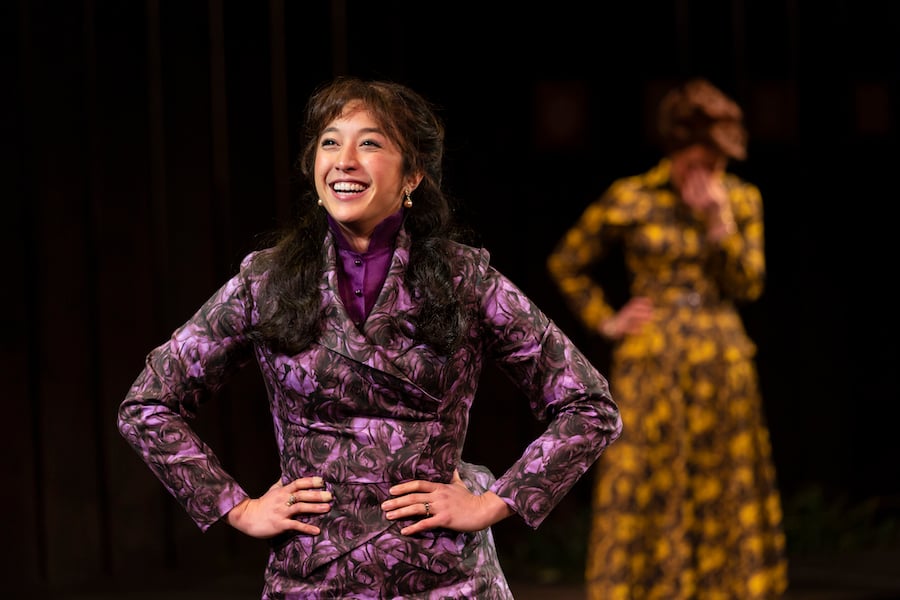
| Sasha Diamond in A Doll's House, Part 2. Performances run through May 26. T. Charles Erickson Photo. |
But A Doll’s House Part 2 is also cumbersome and heavy-handed on exposition. Hnath’s fondness for inside baseball comes on strong: he gets deep in the weeds with Ibsen, sometimes at the expense of both the script and his audience. Twists feel strained and mechanical, with scales that tip toward over-explanation, rehashing, and easy resolution. With a final sequence that is entirely gratuitous, he denies the audience the sublime mess that made his predecessor’s work so very worthwhile.
But even before that, it’s exhausting. The mansplaining—and second-wave feminist-splaining, for that matter— is funny until suddenly it has gone on too long.In Torvald, there’s a male redemption narrative that feels too easy. Where there is supposed to be a play, it seems that Hnath is trying to figure out a woman’s inner dialogue on why the patriarchy’s got her down.
For viewers who have thought about marriage, been married, chosen not to get married, are entering second marriages, experienced mommy wars, incited mommy wars, or won mommy wars, the material feels stale. Not hundreds of years stale, but decades stale. Stale enough that a cast can throw their entire weight behind it, and something is still missing.
As the curtain falls, the audience is left to wonder what Long Wharf Theatre this script was intended for. Is it a Long Wharf that wants to push the envelope, or be perceived as pushing the envelope? A Long Wharf that practices the optics of feminism, but is hesitant to bring in a work that engages with its current core? A Long Wharf that produces a play because it’s in vogue, or produces a play because it’s good?

